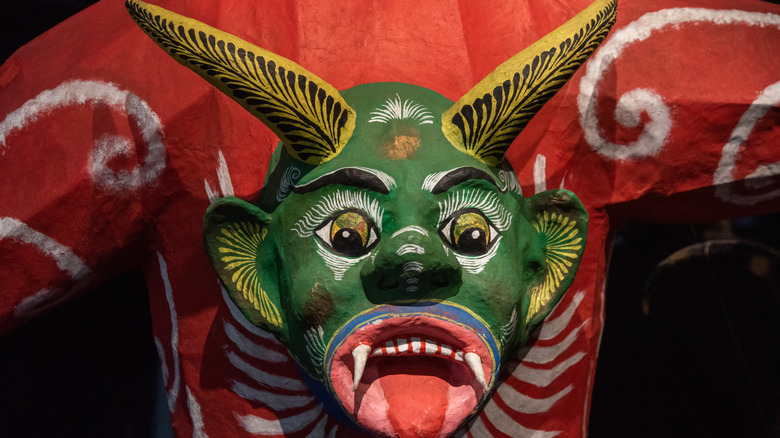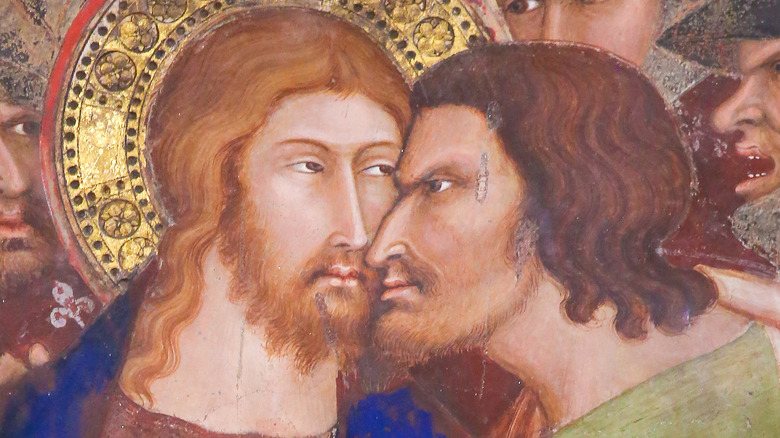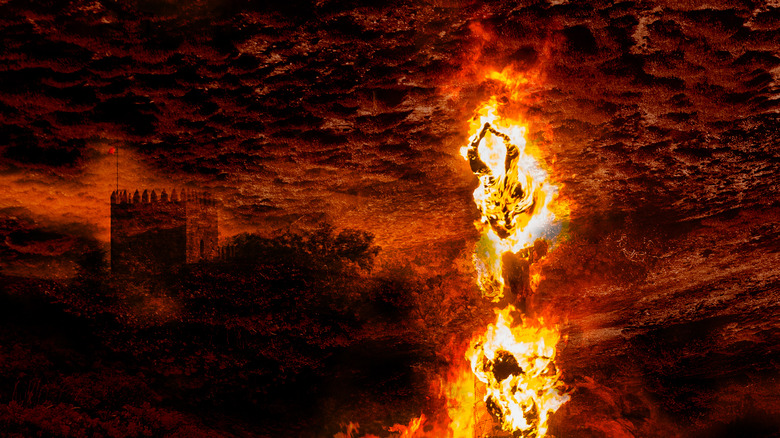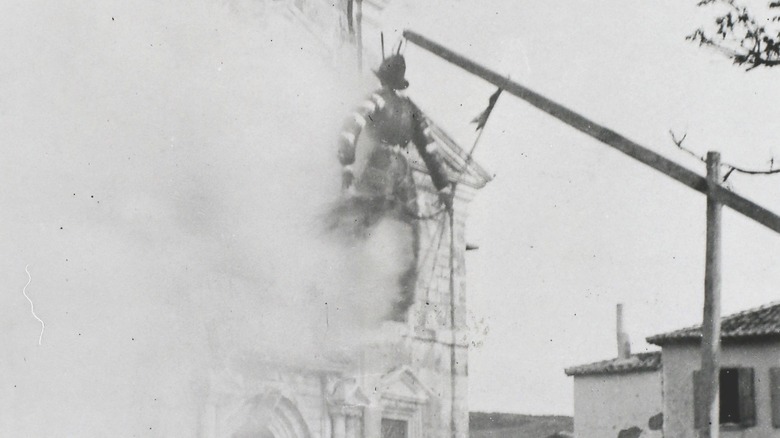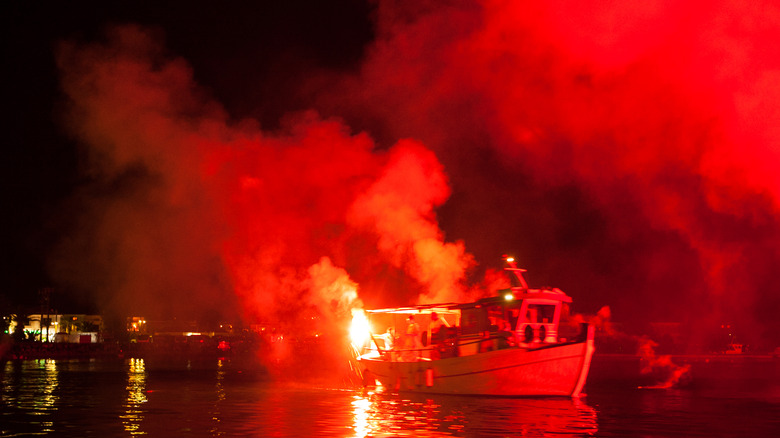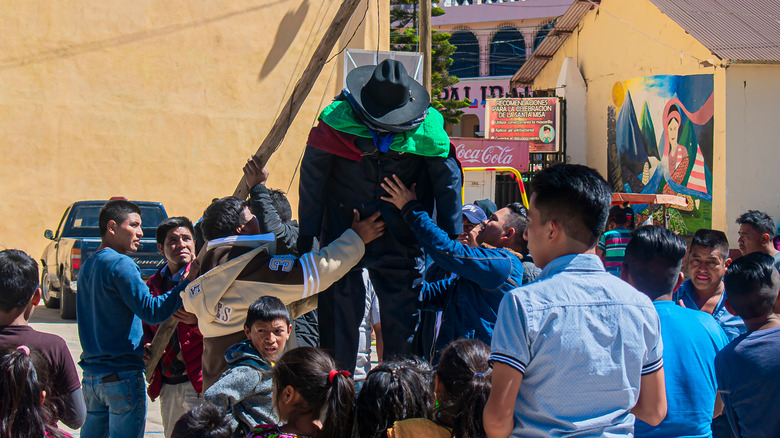What Is The Easter Tradition Of The Burning Of Judas?
The Easter holiday has come to mean many things to different people, secular and religious alike. Traditionally, the holiday honors the resurrection of Jesus Christ following his crucifixion. The story of how Jesus came to be crucified is among the most brutal and harrowing in all of the New Testament. A central player in this narrative of the Passion of Christ was Judas Iscariot. Although not an official part of the liturgical cycle, the Burning of Judas was once commonly practiced all throughout Europe and elsewhere, as part of the Easter celebration, per "The Book of Easter" by William Croswell Doane.
Who was Judas, though? And why do some faithful observers of Easter burn his effigy? Judas is one of the most infamous and controversial characters in Christianity, in fact. And to understand the Easter tradition of the Burning of Judas it's important to first understand the role that Judas played in Christ's crucifixion.
Who was Judas Iscariot?
The first thing to know about Judas Iscariot and the part that he had in the story of Jesus is that he was one of Christ's 12 apostles. During the time of Judas and Jesus, Israel was riven with social and political unrest. Israel was under the rule of Rome, and it was risky to follow a leader like Jesus. And before long, divisions arose between Jesus and Judas, as Christianity explains.
Jesus soon found himself in the crosshairs of Rome, as they sought to quell unrest in Israel. Judas would betray Jesus after the Last Supper, and as a result Jesus was captured and crucified by the Romans. The Bible never explains exactly why Judas did what he did, although there was some financial incentive. The betrayal of Jesus nevertheless made Judas one of the Bible's most infamous and reviled characters, with many anti-semitic stereotypes attributed to him. For this reason, it became practice early on for the faithful to not just celebrate Christ's death and resurrection but to vilify the man who the Bible records as being primarily responsible for putting those events into motion.
What happens during the Burning of Judas?
The Burning of Judas has never been part of the official liturgical cycle, nor the Lenten season itself. Nevertheless, the practice of Burning the Judas, often on Good Friday or Holy Saturday (sometimes called White Saturday), spread throughout the Christian world as part of many Easter celebrations. This is especially true in parts of Europe and the Latin America, as My Czech Republic explains.
Wherever the Burning of Judas was practiced, an effigy of Judas was most often hanged before it was set alight. The effigy might also be beaten or even exploded with fireworks. In one Czech tradition, school children ran through the streets with noisemakers, as if chasing Judas himself in order to frighten him. Church attendees also attempted to chase him out. These practices largely died out in the late 19th century, though, as the Burning of Judas did in much of the rest of the world where it was practiced.
Where was the Burning of Judas most common?
In addition to areas like the Czech Republic and Slovakia, the Burning of Judas was once common throughout much of the Christian world and in Central and South America. That was particularly true in Orthodox and Catholic communities. As recorded by Christina Hole in her book "British Folk Customs," the Burning of Judas in England was once somewhat conflated with Guy Fawkes. The British effigy burned would also often be wearing a similar mask to that which is now often associated with the 17th century Englishman who tried to blow up British parliament, Guy Fawkes (via History).
The Burning of Judas also spread throughout the Latin American world along with Spanish and Portuguese colonization. In the instance of Mexico, papier-mâché effigies of Judas are exploded with fireworks in the public town square. That's why, early on in some parts of Mexico, the Judas effigies were made from hay and rags, as Mexican Folk Art Guide explains.
Here's where the Burning of Judas is still practiced today
The Burning of Judas, in fact, is still practiced in some parts of Mexico, according to the Mexican Folk Art Guide. In many other parts of the world, though, the tradition has largely died out. One town that still ritually burns an effigy of Judas each Easter season is Ermioni, in Greece. In some areas of the world, the practice dates back centuries, but in Ermioni it's relatively new, as the AP explains.
Located on the Greek Peloponnese peninsula, residents and visitors of Ermioni venture out on the water on boats each year for Easter. Then, a wire likeness of Judas is burned on a raft. In some parts of the world where the ritual survives, politicians and even oil executives stand in for Judas in effigy. Such was the case in Venezuela, where the likeness of Judas has resembled an Exxon businessman, as reported by TIME Magazine.
The Burning of Judas is now controversial
Given the brutal and violent nature of the Burning of Judas tradition, as well as concerns over anti-semitic overtones to the practice — Judas himself is said to have been a Jew — the ritual is no longer practiced in many parts of the world. Unfortunately, the ritual itself is sometimes simply called the Burning of the Jew. In 2005, the U.S. State Department formally criticized Greece for continuing its support of the practice in some areas, per TIME Magazine.
In Pruchnik, Poland, in 2019, a Jewish effigy was hanged and burned in Poland on Good Friday as part of their Easter celebration. The World Jewish Congress reacted with disgust and outrage, calling the act deeply disturbing, as the Independent explains. Many Polish residents also disagreed with the practice. "Jews are deeply disturbed by this ghastly revival of medieval antisemitism that led to unimaginable violence and suffering," chief executive of the World Jewish Congress Robert Singer said at the time (via Independent).
